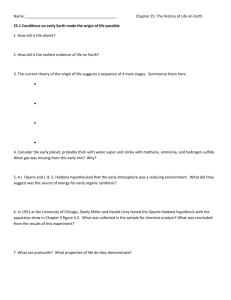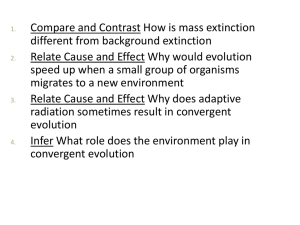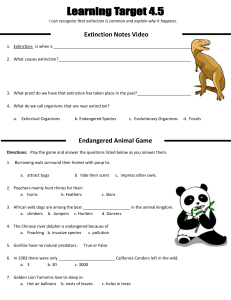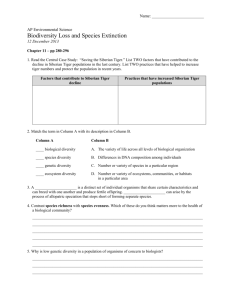Worksheet 4.2 KEY - Iowa State University
advertisement
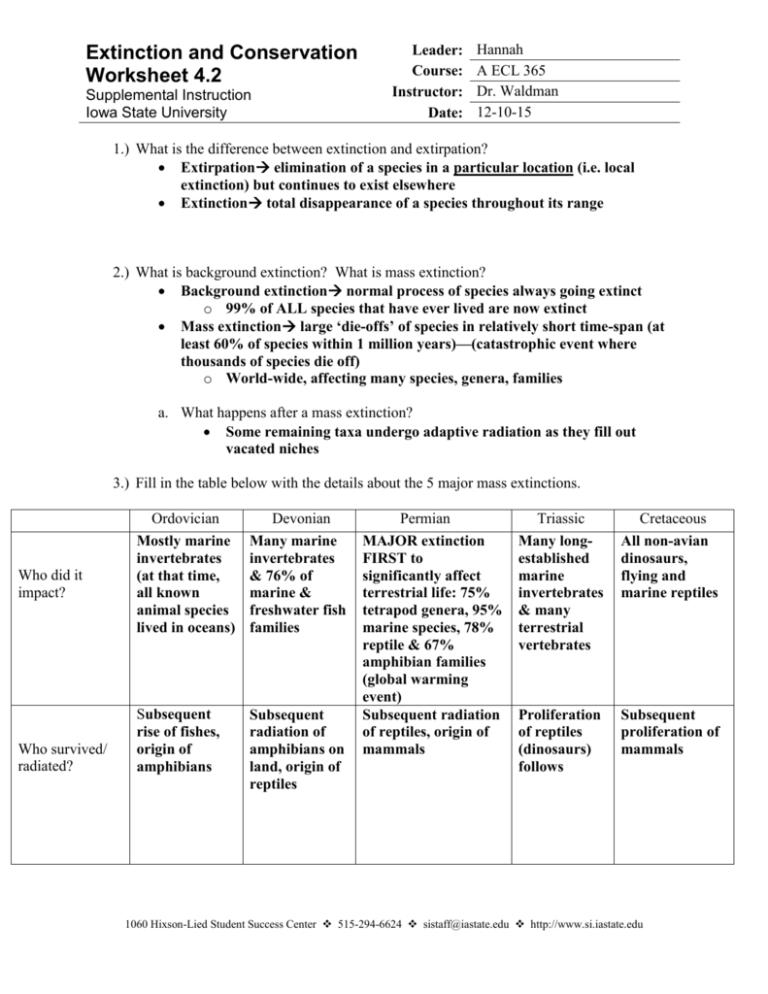
Extinction and Conservation Worksheet 4.2 Supplemental Instruction Iowa State University Leader: Course: Instructor: Date: Hannah A ECL 365 Dr. Waldman 12-10-15 1.) What is the difference between extinction and extirpation? Extirpation elimination of a species in a particular location (i.e. local extinction) but continues to exist elsewhere Extinction total disappearance of a species throughout its range 2.) What is background extinction? What is mass extinction? Background extinction normal process of species always going extinct o 99% of ALL species that have ever lived are now extinct Mass extinction large ‘die-offs’ of species in relatively short time-span (at least 60% of species within 1 million years)—(catastrophic event where thousands of species die off) o World-wide, affecting many species, genera, families a. What happens after a mass extinction? Some remaining taxa undergo adaptive radiation as they fill out vacated niches 3.) Fill in the table below with the details about the 5 major mass extinctions. Who did it impact? Who survived/ radiated? Ordovician Devonian Mostly marine invertebrates (at that time, all known animal species lived in oceans) Many marine invertebrates & 76% of marine & freshwater fish families Subsequent rise of fishes, origin of amphibians Subsequent radiation of amphibians on land, origin of reptiles Permian MAJOR extinction FIRST to significantly affect terrestrial life: 75% tetrapod genera, 95% marine species, 78% reptile & 67% amphibian families (global warming event) Subsequent radiation of reptiles, origin of mammals Triassic Cretaceous Many longestablished marine invertebrates & many terrestrial vertebrates All non-avian dinosaurs, flying and marine reptiles Proliferation of reptiles (dinosaurs) follows Subsequent proliferation of mammals 1060 Hixson-Lied Student Success Center 515-294-6624 sistaff@iastate.edu http://www.si.iastate.edu 4.) What are some characteristics of the Cretaceous extinction? What is the hypothesized cause? Who was not affected? Large meteor hit in Yucatan Increased volcanic activity, increased ash/cloud cover o Limited sunlight lead to environmental changes “Impact” winter (difficult for ectotherms) Collapse of photosynthesis (affect vegetation & food chain) Herbivores die out (no food), carnivores die out (no food) Omnivore, insectivore, scavengers, organisms with ties to water (more likely to survive) 5.) Describe the 6th mass extinction. What makes it different from the other 5? Earth is currently in the 6th major mass extinction—current extinction rate is significantly larger than background extinction and faster than ever before (even Permian extinction) It is unique because it is caused by a single species (humans) o Human impact on earth driving extinction of many species a. What types of methods are causing these current extinctions? Human population growth o Habitat loss and fragmentation o Overfishing/hunting o Invasive/introduced species o Toxicity/contaminants 6.) ___Herps___ are currently most affected by the 6th mass extinction. a. Specifically, ___turtles____ are the most imperiled from the vertebrate group. (slow reproductive rate—takes long time to reach maturity; also very small and distinct feeding/breeding grounds) 7.) Many ____amphibians_____ may be bio-indicators because of their susceptibility to toxicity levels in the environment. 8.) What are some solutions/ conservation efforts that are being made? Wildlife sanctuaries/refuges Ecosystem/habitat restoration Management projects o Wildlife corridors (connect fragmented landscapes) o Repopulation programs o Genetic restoration o Captive breeding Invasive species management Green initiatives 1060 Hixson-Lied Student Success Center 515-294-6624 sistaff@iastate.edu http://www.si.iastate.edu



